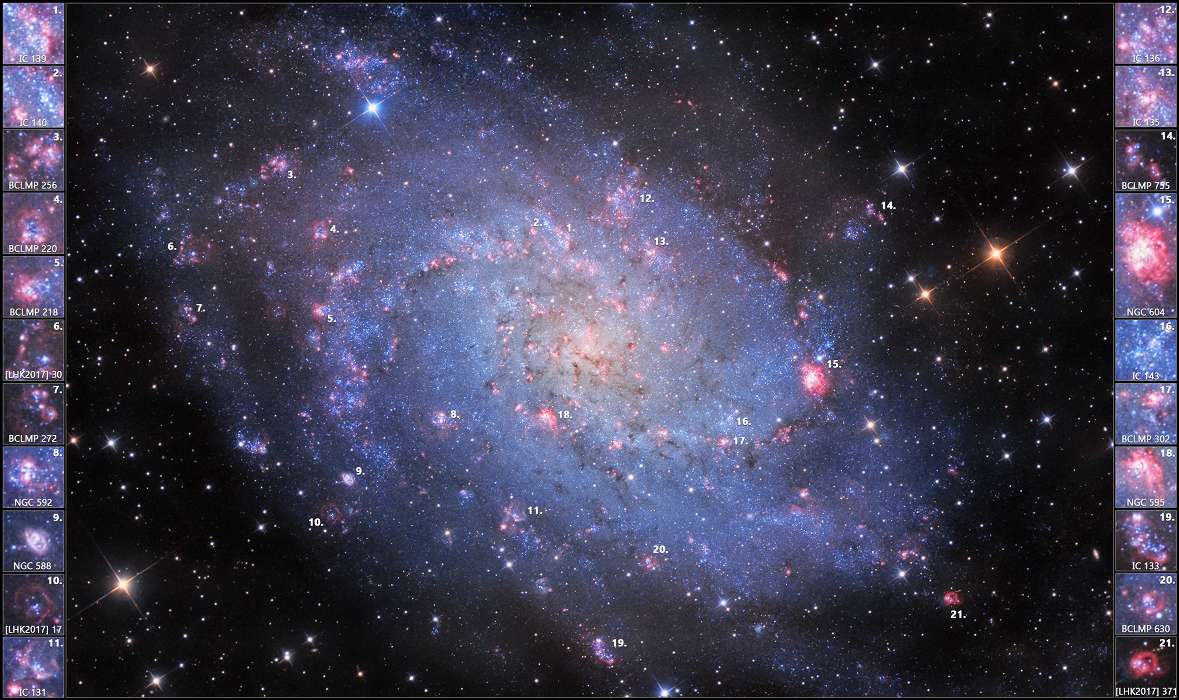30. September 2021
M33 ê 水素雲

探索宇宙1!逐工會揀一幅無仝款 ê 影像抑是相片,𤆬你熟似咱這个迷人 ê 宇宙,閣有專業天文學者2為你3解說4。
- 原始文章:The Hydrogen Clouds of M33
- 影像來源 kah 版權:Luca Fornaciari
- 台文翻譯:An-Li Tsai (NCU)
[漢羅] M33 ê 水素雲
華麗 ê 捲螺仔星系 M33 毋若干焦伊發光 ê 水素氣體爾爾。 伊嘛叫做 三角星系,tī 300 萬光年遠 ê 所在,是本星系群主要 ê 成員之一。 M33 lang-lang ê 捲螺仔手骨 to̍h 絞入去伊 ê 核心。 大型 HII 區 綴著 捲螺仔手骨 ê 方向 leh 行,是目前已經知影 ê 上大 ê 恆星托兒所,to̍h 是 產生短歲壽毋閣大質量恆星 ê 所在。 明亮 ê 大質量恆星 kā 邊仔 ê 水素氣體 離子化了後,發出強烈 ê 紫外光輻射,上尾產生特徵 ê 紅光。 星系 ê 彩色影像是 ùi 闊頻影像資料來 ê。 H-alpha 濾鏡 是記錄狹頻影像資料 ê,伊 kan-na kā 上強 ê 水素發射線 送過來。 為著欲強調這幅望遠鏡影像內底 ê HII 區,to̍h kā 闊頻 kah 狹頻影像敆做伙。 有編號 ê HII 區特寫 to̍h tī 影像雙沿 ê 插入圖。 用逐張插入圖 ê 獨立編號 to̍h 會使揣著伊是 tī 三角星系內底 ê 佗一位。 比論講,大型 HII 區 NGC 604 to̍h tī 正爿插入圖 ê 第 15 號彼位。 Tī 這幅 M33 圖 內底,遐差不多是 tī 星系中心 ê 4 點鐘方向。
[POJ] M-saⁿ-cha̍p-saⁿ ê Chúi-sò͘ hûn
Hôa-lē ê kńg-lê-á seng-hē M-saⁿ-cha̍p-saⁿ m̄-nā kan-na i hoat-kng ê chúi-sò͘ khì-thé niā-niā. I mā kiò-chò Saⁿ-kak-seng-hē, tī saⁿ-pah-bān kng-nî hn̄g ê só͘-chāi, sī pún-seng-hē-kûn chú-iàu ê sêng-goân chit-it. M-saⁿ-cha̍p-saⁿ lang-lang ê kńg-lê-á chhiú-kut to̍h ká-ji̍p-khì i ê he̍k-sim. Tōa-hêng H-two-khu tòe-tio̍h kńg-lê-á chhiú-kut ê hong-hiòng leh kiâⁿ, sī bo̍k-chêng í-keng chai-iáⁿ ê siōng-tōa ê hêng-chhiⁿ-thok-jî-só͘, to̍h sī sán-seng té-hòe-siū m̄-koh tōa-chit-liōng hêng-chhiⁿ ê só͘-chāi. Bêng-liōng ê tōa-chit-liōng hêng-chhiⁿ kā piⁿ-á ê chúi-sò͘-khì-thé lî-chú-hòa liáu-āu, hoat-chhut kiông-lia̍t ê chí-gōa-kng-hok-siā, siōng-bóe sán-seng te̍k-teng âng-kng. Seng-hē ê chhái-sek iáⁿ-siōng sī ùi khoah-pak iáⁿ-siōng chu-liāu lâi ê. H-alpha lū-kiàⁿ sī kì-lo̍k e̍h-pîn iáⁿ-siōng chu-liāu ê, i kan-na kā siōng-kiông ê chúi-sò͘ hoat-siā-sòaⁿ sàng--kòe-lâi. Ūi-tio̍h beh kiông-tiāu chit-pak bōng-oán-kiàⁿ iáⁿ-siōng lāi-té ê H-two-khu, to̍h kā khoah-pîn kah e̍h-pîn iáⁿ-siōng kap-chòe-hó. Ū pian-hō ê H-two-khu te̍k-siá to̍h tī iáⁿ-siōng siang-iân ê chhah-ji̍p-tô͘. Iōng ta̍k-tiuⁿ chhah-ji̍p-tô͘ ê to̍k-li̍p pian-hō to̍h ē-sái chhōe-tio̍h i sī tī Saⁿ-kak-seng-hē lāi-té ê tó-chi̍t-ūi. Pí-lūn-kóng, tōa-hêng H-two-khu NGC lio̍k-khòng-sù to̍h tī chiàⁿ-pêng chhah-ji̍p-tô͘ ê tē-cha̍p-gō͘-hō hit-ūi. Tī chit-pak M-saⁿ-cha̍p-saⁿ tô͘ lāi-té, hiah chha-put-to sī tī seng-hē tiong-sim ê sì-tiám-cheng hong-hiòng.
[KIP] M-sann-tsa̍p-sann ê Tsuí-sòo hûn
Huâ-lē ê kńg-lê-á sing-hē M-sann-tsa̍p-sann m̄-nā kan-na i huat-kng ê tsuí-sòo khì-thé niā-niā. I mā kiò-tsò Sann-kak-sing-hē, tī sann-pah-bān kng-nî hn̄g ê sóo-tsāi, sī pún-sing-hē-kûn tsú-iàu ê sîng-guân tsit-it. M-sann-tsa̍p-sann lang-lang ê kńg-lê-á tshiú-kut to̍h ká-ji̍p-khì i ê hi̍k-sim. Tuā-hîng H-two-khu tuè-tio̍h kńg-lê-á tshiú-kut ê hong-hiòng leh kiânn, sī bo̍k-tsîng í-king tsai-iánn ê siōng-tuā ê hîng-tshinn-thok-jî-sóo, to̍h sī sán-sing té-huè-siū m̄-koh tuā-tsit-liōng hîng-tshinn ê sóo-tsāi. Bîng-liōng ê tuā-tsit-liōng hîng-tshinn kā pinn-á ê tsuí-sòo-khì-thé lî-tsú-huà liáu-āu, huat-tshut kiông-lia̍t ê tsí-guā-kng-hok-siā, siōng-bué sán-sing ti̍k-ting âng-kng. Sing-hē ê tshái-sik iánn-siōng sī uì khuah-pak iánn-siōng tsu-liāu lâi ê. H-alpha lū-kiànn sī kì-lo̍k e̍h-pîn iánn-siōng tsu-liāu ê, i kan-na kā siōng-kiông ê tsuí-sòo huat-siā-suànn sàng--kuè-lâi. Uī-tio̍h beh kiông-tiāu tsit-pak bōng-uán-kiànn iánn-siōng lāi-té ê H-two-khu, to̍h kā khuah-pîn kah e̍h-pîn iánn-siōng kap-tsuè-hó. Ū pian-hō ê H-two-khu ti̍k-siá to̍h tī iánn-siōng siang-iân ê tshah-ji̍p-tôo. Iōng ta̍k-tiunn tshah-ji̍p-tôo ê to̍k-li̍p pian-hō to̍h ē-sái tshuē-tio̍h i sī tī Sann-kak-sing-hē lāi-té ê tó-tsi̍t-uī. Pí-lūn-kóng, tuā-hîng H-two-khu NGC lio̍k-khòng-sù to̍h tī tsiànn-pîng tshah-ji̍p-tôo ê tē-tsa̍p-gōo-hō hit-uī. Tī tsit-pak M-sann-tsa̍p-sann tôo lāi-té, hiah tsha-put-to sī tī sing-hē tiong-sim ê sì-tiám-tsing hong-hiòng.
[English] The Hydrogen Clouds of M33
Gorgeous spiral galaxy M33 seems to have more than its fair share of glowing hydrogen gas. A prominent member of the local group of galaxies, M33 is also known as the Triangulum Galaxy and lies a mere 3 million light-years away. Sprawling along loose spiral arms that wind toward the core, M33's giant HII regions are some of the largest known stellar nurseries, sites of the formation of short-lived but very massive stars. Intense ultraviolet radiation from the luminous massive stars ionizes the surrounding hydrogen gas and ultimately produces the characteristic red glow. To highlight the HII regions in this telescopic image, broadband data used to produce a color view of the galaxy were combined with narrowband data recorded through a hydrogen-alpha filter, transmitting the light of the strongest hydrogen emission line. Close-ups of cataloged HII regions appear in the sidebar insets. Use the individual reference number to find their location within the Triangulum Galaxy. For example, giant [HII region NGC604][HII region NGC604] is identified in an inset on the right and appears at position number 15. That's about 4 o'clock from galaxy center in this portrait of M33.
詞彙學習
| 漢羅 | POJ | KIP | 華語 | English |
|---|---|---|---|---|
| 捲螺仔星系 | kńg-lê-á seng-hē | kńg-lê-á sing-hē | 螺旋星系 | spiral galaxy |
| 捲螺仔手骨 | kńg-lê-á chhiú-kut | kńg-lê-á tshiú-kut | 旋臂 | spiral arm |
| 水素 | chúi-sò͘ | tsuí-sòo | 氫 | hydrogen |
| 本星系群 | pún-seng-hē-kûn | pún-sing-hē-kûn | 本星系群 | local group of galaxies |
| 三角星系 | Saⁿ-kak-seng-hē | Sann-kak-sing-hē | 三角星系 | the Triangulum Galaxy |
| HII 區 | H-two khu | H-two khu | HII 區 | HII region |
| 濾鏡 | lū-kiàⁿ | lū-kiànn | 濾鏡 | filter |
| 闊頻 | khoah-pîn | khuah-pîn | 寬頻 | broadband |
| 狹頻 | e̍h-pîn | e̍h-pîn | 窄頻 | narrowband |
| 特徵線 | te̍k-teng-sòaⁿ | ti̍k-ting-suànn | 特徵線 | characteristic line |